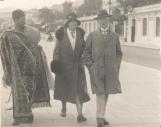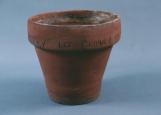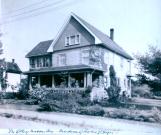2
Trip to EuropeIn 1930 John Hagen retired from his career with the Halifax and Bermuda Cable Company, and he and his wife" set out for an extended tour of Europe. Not surprisingly Alice Hagen was especially interested in visiting potteries. She toured well known china manufacturers in England, France and Italy. While in London she visited a Persian Art Exhibit where she saw the early lustre wares of the Near East.
Hagen's interest in pottery as occupational therapy reflected an important trend in social welfare thinking in the interwar years. "In France, she saw disabled veterans making pottery. She marvelled at the absorption in their faces, realizing what an emotional satisfaction it must be to them, apart from earning them a living. Why couldn't disabled people everywhere learn to handle the sensuously pliable clay? How marvellous to start such an industry in her own province in Canada, where the lack of industries was so often deplored! Her idea became a determination and home again she prepared to make it work." (1)
(1) Kay Hill, "Nova Scotia's Pioneer Potter: Alice Mary Hagen of Mahone Bay," Atlantic Advocate, August 1959, pp. 43-47.
4
Alice Hagen becomes a potterOn her return to Nova Scotia, Alice Hagen was determined to learn to make pottery herself so that she could teach others. She was curious about whether suitable clay body and glaze materials were to found in the province. To learn to throw on the wheel she approached Robert Prescott, a potter who made flower pots at a factory in Lantz, NS. From him she learned to use Nova Scotia's native earthenware clay. To learn to use glazes she experimented on her own.
As soon as she learned to make pots she wanted to begin teaching. Her first attempt was made at the School for the Deaf in Halifax. With the support of the school's secretary, arrangements were made for a teacher in the school to take Hagen's course, but general interest was lacking and further progress in that direction failed. Hagen went on alone, forming classes wherever people could be persuaded to come and learn. (1)
(1) Hill, "Nova Scotia's Pioneer Potter."
6
Mahone BayWhen Alice and John Hagen returned from their year in Europe they settled in a new Hydrostone house in the town of Mahone Bay on the South Shore of Nova Scotia, a short train or car ride from the home of their daughter Rachel and her husband Dr. Duncan Campbell and their three sons in Bridgewater. Alice Hagen was able to use the basement as her pottery workshop and a large sunny room on the second floor as a studio. She remained in the house until a few months before her death when she moved into a nursing home in Bridgewater.


